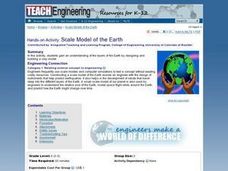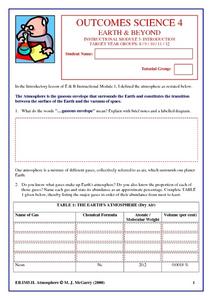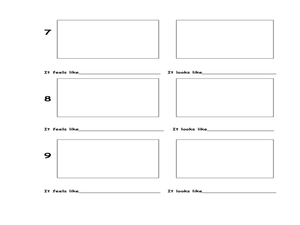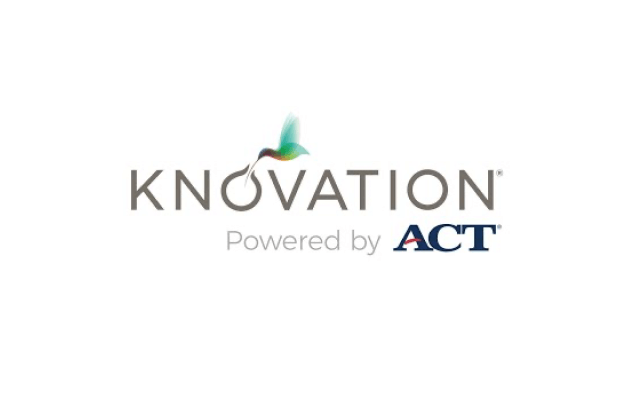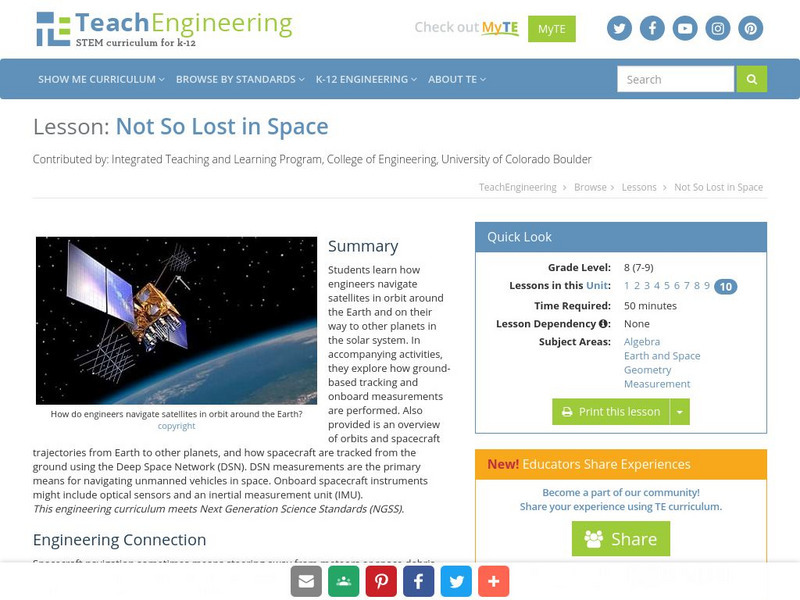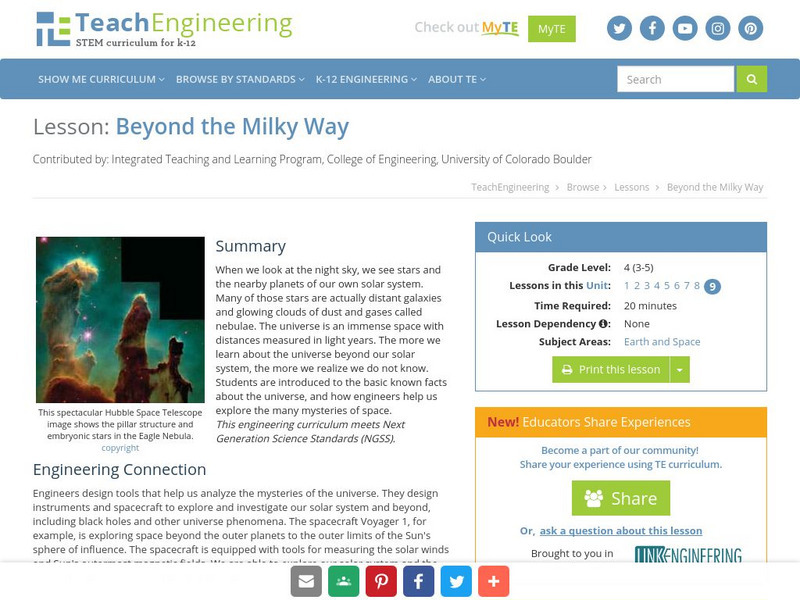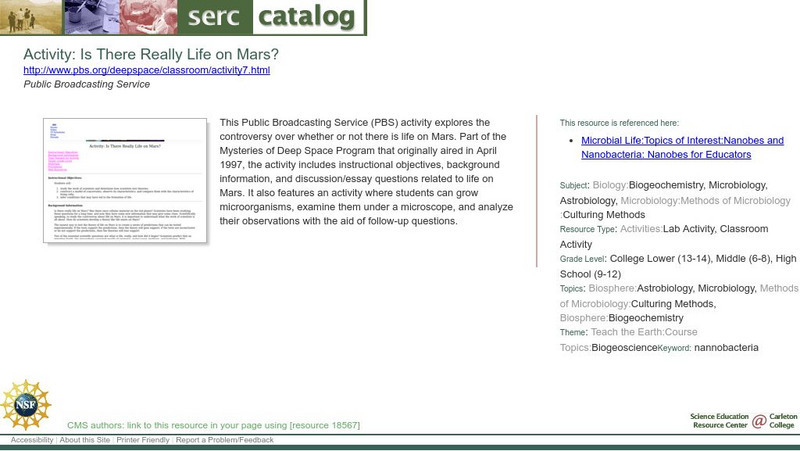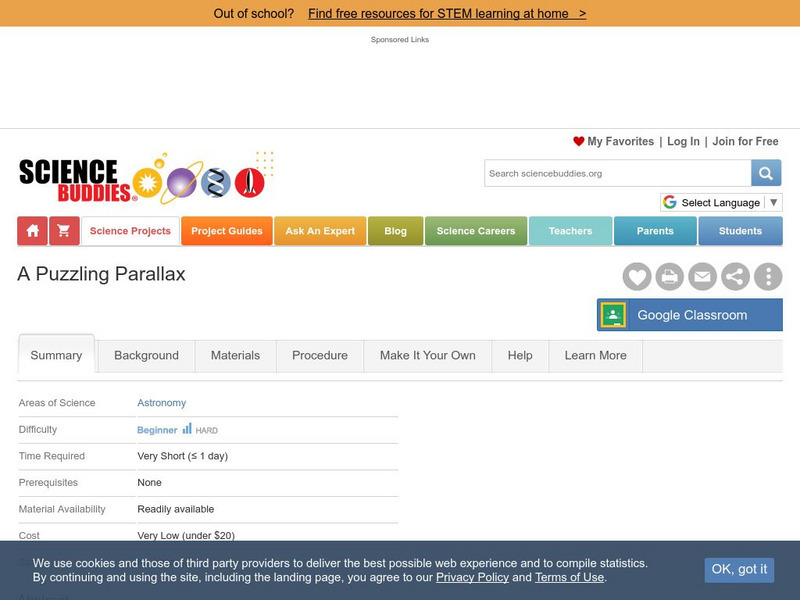Curated OER
Scale Model of the Earth
Students work together to create a model of the Earth. They label and identify each layer and describing its properties. They discover how engineers use models to test different concepts.
Curated OER
Measuring Elevation
Students practice measuring elevation, one of the key coordinates used by astronomers. They describe how the elevation of an object is measured.
and combine compass directions and elevation to find celestial objects.
Curated OER
Alien Visitor's Rewrite
Students role play the role of an alien who analyzes how the media represents the different social groups. In groups, they write their own story in which they add or revise a character to make it non-stereotypical. They share their...
Curated OER
Everybody Needs a Rock
Second graders examine science non-fiction books in the 500 section of the media center. They listen to Byrd Baylor's, Everybody Needs a Rock, and write a sentence that tells why everyone does need a rock. They illustrate the sentence.
Curated OER
Dimming the Sun
Learners collect, interpret and analyze weather variable data. They describe atmospheric variables that affect evaporation. Students create graphs and analyze the information collected.
Curated OER
Animals and People: Who's Behaving Badly?
Young scholars explore the relationship between human beings and animals. They participate in a variety of activities to examine animal behavior. Students create a class book and stage a mock news broadcast.
Curated OER
Scientific Theories
Ninth graders compare and contrast how different models can be used to represent scientific understandings. They evaluate the use of data when considering scientific claims. Students debate a variety of socio-scientific issues and the...
Curated OER
Earth and Beyond
In this earth and beyond worksheet, students answer short answer questions about the atmosphere, the chemical compounds in Earth's atmosphere. Students visit different websites to conduct research of the discoveries of the scientist who...
Curated OER
How Does Climate Influence Civilization
Students demonstrate their knowledge of the Earth's systems. In this climate lesson students identify the climate of a chosen area and the effects it has on the lifestyles of those living there.
Curated OER
Exploring Marine Objects
Young scholars identify the sources of water on Earth. For this life science lesson, students list the different plants and animals that live in the ocean. They explore marine objects in the lab and draw them.
NASA
Nasa: Kepler: A Search for Habitable Planets: Transit Tracks
Classroom lesson for teaching astronomy uses PowerPoint presentations and illustrations of Kepler's light curves used to discover planets.
TeachEngineering
Teach Engineering: Not So Lost in Space
Middle schoolers learn how engineers navigate satellites in orbit around the Earth and on their way to other planets in the solar system. In accompanying activities, they explore how ground-based tracking and onboard measurements are...
TeachEngineering
Teach Engineering: Get Me Off This Planet
The purpose of this lesson plan is to teach students about how a spacecraft gets from the surface of the Earth to Mars. The lesson plan first investigates rockets and how they are able to get us into space. Finally, the nature of an...
PBS
Pbs Teachers: Math Space Odyssey: How Much Do You Weigh in Outer Space?
Demonstrate the ability to apply the use of decimals, fractions, ratios and proportions to situations based upon given information about planets in the solar system.
TeachEngineering
Teach Engineering: The Outer Planets
Students explore the outermost planets of our solar system: Saturn, Uranus and Neptune. They also learn about characteristics of Pluto and its interactions with Neptune. Students learn a little about the history of space travel as well...
Other
Lunar and Planetary Institute: Explore! Discover Earth
A variety of hands-on activities, investigations, and explorations designed to engage learners in discovering planet Earth.
Other
Lunar and Planetary Institute: Explore! Jupiter's Family Secrets
A variety of hands-on activities, investigations, and explorations designed to engage learners in discovering planet Jupiter.
Other
Nutrients for Life Foundation: For Teachers: Nourishing the Planet
Download free curriculum with three modules on soil and plant science: elementary, middle, or high school. Each module includes hands-on investigations to help learners understand the importance of healthy soil and thriving plant...
Other
Nutrients for Life Foundation: For Teachers: Nourishing the Planet
Download free curriculum with three modules on soil and plant science: elementary, middle, or high school. Each module includes hands-on investigations to help learners understand the importance of healthy soil and thriving plant...
PBS
Pbs Teachers: Life's Really Big Questions: Planetary Problem Solving
Explore the possibility of life on planets outside our solar system. Create an extrasolar planet, then make the necessary adaptations for it to be capable of supporting human life.
TeachEngineering
Teach Engineering: Beyond the Milky Way
When we look at the night sky, we see stars and the nearby planets of our own solar system. Many of those stars are actually distant galaxies and glowing clouds of dust and gases called nebulae. The universe is an immense space with...
Science Education Resource Center at Carleton College
Serc: Activity: Is There Really Life on Mars?
This Public Broadcasting Service (PBS) activity explores the controversy over whether or not there is life on Mars. Part of the Mysteries of Deep Space Program that originally aired in April 1997, the activity includes instructional...
PBS
Pbs Teachers: Mysteries of the Universe
Consider the issues surrounding the world of space exploration including the new fields of archaeoastronomy and astrobiology. Investigate zero gravity, the Big Bang theory, life in space and how sound travels in a vacuum.
Science Buddies
Science Buddies: A Puzzling Parallax
Did you know that ancient astronomers could measure the distance to other stars? They could also distinguish between stars and planets. How could they do that without modern technology of telescopes? See if you can discover the link...
Other popular searches
- Space and Planets
- Science Space and Planets
- Space, Stars and Planets
- Space Inner Planets
- Space Stars and Planets
- Outer Space Outer Planets
- Space Planets
- Space\, Stars and Planets
- Poetry Space and Planets
- Space Planets Scale
- Space\\, Stars and Planets
- Space and Planets Practical


